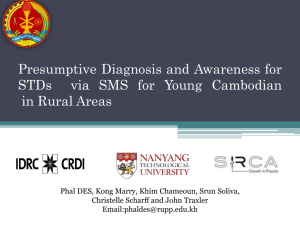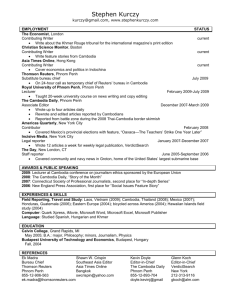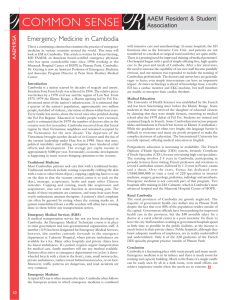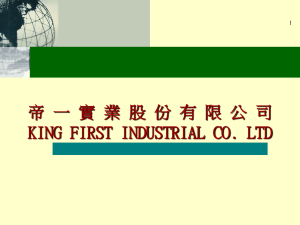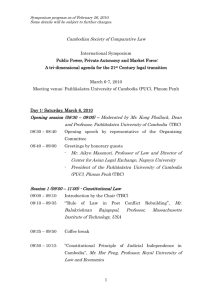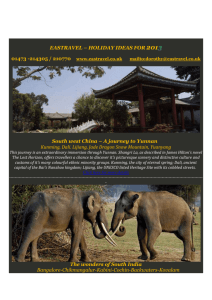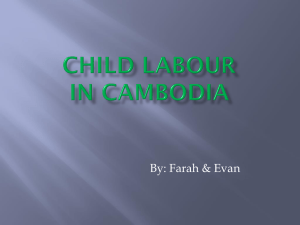Document 10464881
advertisement
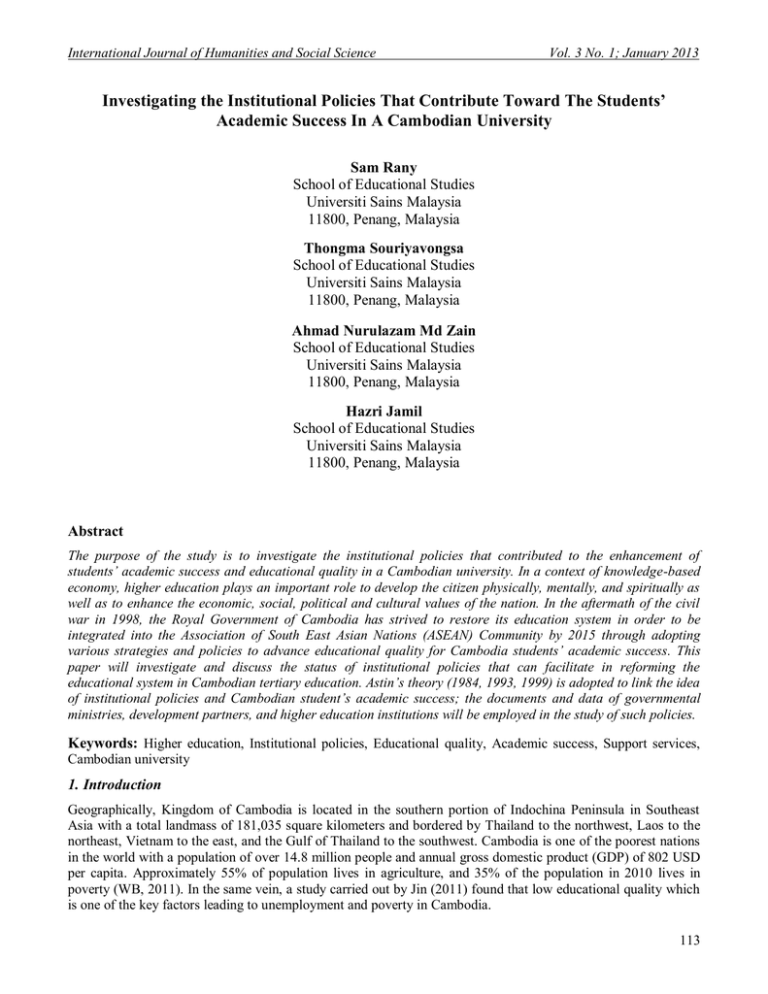
International Journal of Humanities and Social Science Vol. 3 No. 1; January 2013 Investigating the Institutional Policies That Contribute Toward The Students’ Academic Success In A Cambodian University Sam Rany School of Educational Studies Universiti Sains Malaysia 11800, Penang, Malaysia Thongma Souriyavongsa School of Educational Studies Universiti Sains Malaysia 11800, Penang, Malaysia Ahmad Nurulazam Md Zain School of Educational Studies Universiti Sains Malaysia 11800, Penang, Malaysia Hazri Jamil School of Educational Studies Universiti Sains Malaysia 11800, Penang, Malaysia Abstract The purpose of the study is to investigate the institutional policies that contributed to the enhancement of students’ academic success and educational quality in a Cambodian university. In a context of knowledge-based economy, higher education plays an important role to develop the citizen physically, mentally, and spiritually as well as to enhance the economic, social, political and cultural values of the nation. In the aftermath of the civil war in 1998, the Royal Government of Cambodia has strived to restore its education system in order to be integrated into the Association of South East Asian Nations (ASEAN) Community by 2015 through adopting various strategies and policies to advance educational quality for Cambodia students’ academic success. This paper will investigate and discuss the status of institutional policies that can facilitate in reforming the educational system in Cambodian tertiary education. Astin’s theory (1984, 1993, 1999) is adopted to link the idea of institutional policies and Cambodian student’s academic success; the documents and data of governmental ministries, development partners, and higher education institutions will be employed in the study of such policies. Keywords: Higher education, Institutional policies, Educational quality, Academic success, Support services, Cambodian university 1. Introduction Geographically, Kingdom of Cambodia is located in the southern portion of Indochina Peninsula in Southeast Asia with a total landmass of 181,035 square kilometers and bordered by Thailand to the northwest, Laos to the northeast, Vietnam to the east, and the Gulf of Thailand to the southwest. Cambodia is one of the poorest nations in the world with a population of over 14.8 million people and annual gross domestic product (GDP) of 802 USD per capita. Approximately 55% of population lives in agriculture, and 35% of the population in 2010 lives in poverty (WB, 2011). In the same vein, a study carried out by Jin (2011) found that low educational quality which is one of the key factors leading to unemployment and poverty in Cambodia. 113 © Centre for Promoting Ideas, USA www.ijhssnet.com Compared with her neighboring countries in the region, Cambodia ranks 139th of the 187 countries, in the area of human capital, with Singapore at 26th, Brunei at 33th, Malaysia at 61st, Thailand at 103th, Indonesia at 124th, Vietnam at 128th, Laos at 138th, and Myanmar at 149th respectively (UNDP, 2011). In order to increase a number of human capitals, Cambodia has undertaken numerous reforms to balance the quality and quantity of all educational levels. The government has established numerous institutions and adopted national strategies including the Accreditation Committee of Cambodia (ACC) in 2003, the National Supreme Council of Education (NSCE) in 2005, the Rectangular Strategy for Growth, Employment, Equity and Efficiency in 2003-2012, the National Strategic Development Plan Update 2009-2013, and the Education Law (Chealy, 2009). Moreover, the Cambodian prime minister has recommended that HEIs should create their educational strategies and policies to strengthen the quality of teaching, curriculum, and examinations and to assure a balance of quality and quantity in order to achieve recognition at regional and international levels (Sen, 2011 ). The four top public universities are the Royal University of Phnom Penh (RUPP), the Royal University of Law and Economics (RULE), the National University of Management (NUM) and the University of Health Science (UHS) were selected in this study. This paper discusses on Astin’s theory (1984, 1993, 1999) which describes institutional policies as they link with Cambodian students’ academic success in these public universities. Furthermore, these institutional policies mainly focus on the existing academic supported services and non-academic supported services in Cambodian public universities that can help students to achieve their academic success. Therefore, the next section will examine the recent development of institutional policies within higher education institutions in Cambodia. 2. Recent development of Cambodian higher education institutions Due to the development of higher learning institutions in the global and regional contexts, Cambodia has been paying attention on national policies for strengthening her educational system since 1994. First, consultative meetings between government and development partners were conducted to find out possible recommendations to reform the Cambodian higher education institutions. Remarkably, since the Government had implemented the privatization policies in 1997, there were two important changes at that time. First, the government has permitted the private sector to be involved in tertiary education. Second, the government has authorized Public Higher Educational Institutions (HEIs) to enroll non-scholarship students on a tuition fee paying basis to study in their institutions with government scholarship students who were competitively selected by the ministry of education, youth, and sport based on their grade 12 examination results (Chamnan & Ford, 2004). Consequently, the Norton University (NU), the first private university was established to provide educational services with affordable tuition fees together with other public universities in 1997. Now, there are 91 Cambodian higher education institutions, comprised of 34 public and 57 private universities, in 19 provinces and in Phnom Penh, the capital. Consequently, the expansion of higher education institutions is reflected in the growth of the number of enrollments. According to a report of the Ministry of Education, Youth and Sport, the total annual registration rate has increased dramatically more than four times from 57,828 to 246,069 between 2003 and 2012, with approximately 91 percent of students paying fees in the public and private HEIs. Especially, in the academic year 2011-2012, there were 1006 doctoral students, 14,127 master students, 207,666 undergraduate students, and 23,123 associate students (MoEYS, 2012). However, the rapid growth of HEIs and their enrollment has led to the realization of the need to confront both the low quality of education, and at the same time, the fact that the large number of educated graduates may not be equally matched with market demands (Chealy, 2009). To deal with such matters, the Cambodian parliament and government have adopted a number of national and institutional policies and regulations. This study will highlight the existing national policies, legal frameworks, and institutions for supporting students’ academic success and education quality in the next section. 3. Current status of national policies for Cambodian higher education institutions The Royal Government of Cambodia has established educational strategies and policies as well as legal instruments to assist higher educational institutions in providing their educational services. In fact, institutional and national policies have associated with academic success and education quality. As stated earlier, two fundamental legal instruments determine the government’s commitment to these educational policies. First, article 65 of the Cambodian constitution stipulates that, “the state shall protect and upgrade a citizen’s right to quality education at all levels and shall take necessary steps for quality education to reach all citizens. 114 International Journal of Humanities and Social Science Vol. 3 No. 1; January 2013 The state shall respect physical education and sports for the welfare of all Khmer citizens. In addition, the state shall establish a comprehensive and standardized educational system through the country that shall guarantee the principles of educational freedom and quality to ensure that all citizens have equal opportunity to earn a living (RGC, 1999)”. Second, based on the government strategy in rectangle 4 stated that “the Royal Government will continue to strengthen its partnerships with the private sector and the national and international community to enhance and improve the quality of education services, both in vocational and technical training and in higher education, consistent with international standards and the development needs of the nation (Sen, 2004)”. This section will highlight national policies, legal framework and regulations, institutions that are linked with institutional policies for students’ academic success. 3. 1 National strategy on education 3.1. 1 Educational Strategic Plan 2006-2013 (Education for All) There are two stages of implantation of the Education Strategic Plan from 2006 to 2013. The first stage is the Education Strategic Plan (ESP) 2006–2009, which includes the main purposes for the success of the plan. In order to achieve the goals, the government has introduced the policies in this strategic plan including increased access and equity of enrollment opportunity to realize the Royal Government of Cambodia’s pro-poor policy (MoEYS, 2010 ). The second stage is the Education Strategic Plan (ESP) 2009–2013, which is established to ensure the linkages between education policies and strategies within the frameworks of development and action programs. In this stage, the Ministry of Education continues to provide the highest priority for equitable access to quality education, in particular, to basic education in order to attain goals of the National Education for All (EFA) Plan by 2015. Furthermore, it gives greater chances to expanding early childhood education, non-formal education, technical and vocational training and opportunities to access secondary education and post-secondary education by establishing good relationship with development partners, private sectors, non-governmental organizations, communities and parents. 3.1.2 The Master plan for research in the education sector 2011-2015 The Master Plan for Research in the Education sector which supports the seven strategies of the Policy on Research Development in the Education Sector was approved by the Ministerial Meeting on March 14, 2011, and is guaranteed in articles 18 and 28 of the Cambodian Education Law. This master plan has been technically and financially supported by the World Bank’s Higher Education Quality and Capacity Improvement Project (HEQCIP), and has mainly demonstrated on three significant purposes to increase the number of articles published by Cambodian academicians in national and international academic journals (RGC, 2011). The Master Plan also describes strategies and training programs that will facilitate research development in higher education and enhance the research capacity of academic staff and institutions. 3.2 Legal frameworks and regulations Many laws and regulations have been adopted by Cambodia's parliament and government to support educational policies for facilitating the academic functioning of institutions, to improve tertiary educational quality, and to strengthen quality assurance. These legal frameworks comprised of the Sub-Decree on Creating and Administering of Higher and Technical Education Institutions of 1992, the Royal Code on promulgating the Law on the Establishment of the Ministry of Education, Youth and Sports in 1996, and the Sub-Decree on Criteria of University in 2002. Other regulations are passed by the various legislative and executive institutions such as the Royal Decree on the Accreditation of Higher Education in 2003, the Resolution on the Credit Exchange System and the Implementation of Curricula in the Credit System and Credit Transfer in 2004, the Royal Degree on Promulgating the Law on Education in 2007, and the Sub Degree on PhD Training Program in 2010. Besides providing legal frameworks, some institutions actively participate in enhancing the educational quality of the current Cambodian educational system. Therefore, this paper will investigate educational institutions that support the enhancement of educational quality in Cambodia. 115 © Centre for Promoting Ideas, USA www.ijhssnet.com 3.3 Educational institutions There are three prominent institutions that actively participate in helping the government to implement the national educational policies and strategies and to strengthen the educational quality in Cambodian higher education institutions. These institutions are the Accreditation Committee of Cambodia, the Supreme National Council of Education, and the Directorate Department of Higher Education. 3.3.1 The Accreditation Committee of Cambodia (ACC) The Royal Government of Cambodia has established the Accreditation Committee of Cambodia (ACC), an independent institution, which supervised by the Council of Ministers. However, it has been functioning as an external quality assurance entity that has legitimate powers to evaluate the educational quality of all HEIs throughout the country (RGC, 2003b). In order to ensure the quality of HEIs, the ACC has used nine minimum quality assurance standards of an HEI. They are including Mission (1), Governing structure (2), Management and planning (3), Academic program (4), Academic staff (5), Student and student services (6), Learning service (7), Physical plants (8), financial planning and management, and (9) Dissemination of information (ACC, 2009). In addition, after receiving a license from the Royal Government of Cambodia to operate its institution, each HEI is subjected to an evaluation of its management system, academic quality, and curricula in order to obtain the accreditation certificate. Only Cambodian HEIs accredited by the ACC, have the right to award bachelor, master and Ph.D. degrees in accordance with article 2 of Royal Decree on the Accreditation of Education Quality in Higher Education (RGC, 2003a). In short, this institution has significant roles to facilitate alignment of HEIs performance to meet the high educational quality standard requirements. 3.3.2 The Supreme National Council of Education (SNCE) Presently, the Supreme National Council of Education (SNCE), directly supervised by the Cabinet of the Prime Minister, is in existence to support the Cambodian Education Law. This institution has three main tasks to promote educational quality, to evaluate work in the areas of education, and to mobilize a range of resources for the purpose of education (RGC, 2007). This council has the highest authority over the Ministry of Education, Youth and Sport (MoEYS) and the Accreditation Committee of Cambodia (ACC). Therefore, this council is a crucial mechanism to achieve the goal of educational quality and students’ academic success. 3.3.3 The Directorate Department of Higher Education (DDHE) The Directorate of Higher Education in Cambodia, unlike in other ASEAN countries, is structured under the Ministry of Education, Youth, and Sports (MoEYS). It has two main departments: the Department of Higher Education and the Department of Scientific Research. Frist, Department of Higher Education has three key roles to provide licenses and assist HEIs in developing academic curricula and management instruments needed to meet accreditation standards, and to improve the quality and efficiency of higher education nationwide. Second, the Department of Scientific Research is established to facilitate the educational functioning of HEIs at the master’s and PhD degree levels, and to improve the quality of learning-teaching and research at postgraduate levels through updating teaching methodologies and curriculum development, research and innovation, and publication. In short, this department has a fundamental role to assist the government ministries to implement their policies and strategies in order to promote Cambodian tertiary educational quality. The theory of Astin, employed to link institutional policies and academic success, is discussed in the next section. 4. Astin’s theory of institutional policies and academic success Astin’s (1984, 1993, 1999) “Theory of Student Involvement” provides a means for theoretical guidelines of the process of academic success and persistence of students in their academic environment. Astin’s InputEnvironment-Output/Outcome (I-E-O) model is adopted as the theory to illustrate the linkages among three elements such as the students’ characteristics and background (Input), institutional policies (Environment), and students’ academic success (Output). 116 International Journal of Humanities and Social Science Vol. 3 No. 1; January 2013 As mentioned by this theory, input was referred to personal characteristics of the student at the time before enrolling in the institution (Astin, 1993). The highlighted characteristics of input may be family background, marital status, age, gender, race, parental education, housing, academic self-concept, social experiences, achievement expectancies, and past experiences. Environment in this context is defined as institutional policies on academic resources to facilitate the learning atmosphere of the student including various programs, policies, faculties, peers and educational experiences (Astin, 1993, p. 7). The outcome is identified as the students’ resultant characteristics such as knowledge, skills, critical thinking, attitudes, values, beliefs, and behavior after involving in the academic environment and the student’s level of academic success (Astin, 1993, 1999). This study has adopted this model because it focuses on the institutional environment that comprises of academic and non academic support services which are currently provided by Cambodia's higher learning institutions. Astin suggested that factors which significantly contribute to students’ persistence demonstrate the extent of their involvement in college, particularly with their friends, administrators, faculty members, and institutional programs that are offered to them. He also defines “student involvement" as "the amount of physical and psychological energy that a student devotes to the academic experience” (Astin, 1984 ). Students, who are highly involved in their academic activities, try their best efforts to study, spend much time on campus, participate actively in student associations or organizations, and interact regularly with their friends, administrators, and faculty members. In order to facilitate student engagement, institutions must design more effective learning environment policies that support student involvement, and provide support services for students to be involved in. In short, Astin’s theory suggests that academic success is related to various academic and non academic support services that are provided in Cambodian Higher Education Institutions. 5. Institutional policies for students’ academic success in the campus environments As stated earlier, the Cambodian government has actively taken the lead on institutional policies through providing financial support or allocations for academic activities such as research and innovations, national policies, legal frameworks, and regulations. It also has important roles to facilitate the institutional functions and their academic supported service environment. In addition, institutions need to have a high commitment to provide excellent support services for facilitating students’ academic success and education quality. Institutional commitment refers to “the willingness to invest resources and provide the incentives and rewards needed to enhance students’ academic success, p. 99” (Tinto, 2005). In this paper, there are two kinds of institutional policies that can be significant factors to support students’ education quality progress such as academic and non- academic supported services in this present context. Hence, academic support services consist of academic foundation studies, foreign languages, library services and other facilities. Non-academic services refer to financial support, scholarships, and accommodation. 6. Academic support services Cambodian public higher educational institutions have provided appropriate academic support services in according to the national and regional standards including the minimum standards for Cambodian Accreditation of Higher Education Institutions and the ASEAN Network Quality criteria. There are nine minimum standards to promote quality education and academic success. Introduced in the third standard is the academic program, in the fifth standard is student services, and in the sixth standard is learning services (RGC, 2003a). Academic programs are course curricula designed to ensure and enhance the quality of education in the institutions, and they must comply with national policies, the institutional mission, social needs, the employment market, and students’ needs. Student and student services are defined as academic and non-academic services that contribute to the enhancement of educational quality and the student’s development of knowledge, competence, and professional skills. Support services include admission services, tuition fees and scholarship services, counselling services, accommodation services, food services, first aid services, security services, and other services. Access to libraries, computer, laboratories, experimental rooms, research stations, the Internet, textbooks, journals, research papers, and so on are considered as learning services as these facilities facilitate students’ learning experiences in order to attain their academic success. In the second criteria about teaching and learning of the ASEAN University Network Quality-Assurance, academic support services also include course curriculum, academic staff, student assessment, learning process, environment, health and safety standards and learning resources (ASEAN, 2004). 117 © Centre for Promoting Ideas, USA www.ijhssnet.com Thus, Cambodian public universities are effectively implementing some minimum educational quality standards to provide excellent academic and non academic support services for Cambodian students to achieve their academic development and effectiveness. At the time of writing of this paper, the Cambodian public universities were providing academic support services such as academic foundation studies, English language, library services and other facilities to support the learning environment of Cambodian students. 6.1 Academic foundation studies To upgrade and strengthen the general foundation of knowledge of high school students to succeed at the tertiary level, the Royal Government of Cambodia, through the Accreditation Committee of Cambodia, has introduced foundation study programs into Cambodian HEIs in order to promote the education quality of students. Generally, Cambodian HEIs establish their own independent academic foundation departments which are accredited by the Accreditation Committee of Cambodia. These departments offer foundation studies to first year students in the undergraduate program in the academic year 2005-2006 (ACC, 2005). Thereafter, the ACC has accredited undergraduate and postgraduate curricula. In order to obtain a bachelor’s degree, freshman students must successfully complete a one-year foundation studies program. After that, they are awarded with a foundation study certificate of achievement in all subjects in the foundation study curriculum. With this certificate, students have the right to enroll in the second year of the undergraduate program in the same higher education institution or in another accredited higher education institutions anywhere in the country. Currently, 38 Cambodian universities’ academic foundation programs have been fully accredited by the Accreditation Committee of Cambodia (ACC, 2008). According to article 30 of the Royal Degree on the Accreditation of Education Quality in Higher Education, academic foundation curriculums are required to introduce four compulsory disciplines: Arts and Humanities, Mathematics, Natural Science and Computer Science, Social Science, and Foreign Languages respectively (RGC, 2003a). The Discipline of Arts and Humanities includes subjects such as Literature, History, Philosophy, Fine Art, Musicology, Archaeology, Religious Studies, Khmer Studies, and other courses approved by the ACC. The discipline of Mathematics, Natural Science, and Computer Science includes subjects such as Mathematics, Chemistry, Biology, Physics, Geometry, Environmental Studies, Applied Computer, and other courses approved by the ACC. The discipline of Social Science includes subjects such as Political Science, Public Administration, Sociology, Anthropology, Psychology, Economics, Geography, Demography, and other courses approved by the ACC. The Discipline of Foreign Languages includes the languages of English, French, and other languages. In this foundation study program, students must complete common courses and orientation courses required by the foundation department of HEIs. For instance, the Royal University of Phnom Penh, the oldest and most prestigious university in Cambodia, offers 40 credits or 600 hours for foundation studies. If students want to achieve a bachelor’s degree in Science majoring in Mathematics at the RUPP, they are required to study compulsory courses in English 1 and 2, Khmer Literature, Khmer Culture and Civilization, General Mathematics, General Chemistry and Physics, Using Library Resources and Demography, Statistics, Computer Applications, General Geography, General Algebra 1 and 2, and General Analysis 1 and 2 (RUPP, 2012f). Similarly, the Royal University of Law and Economics, one of ASEAN Network University members, provides 36 credits or 540 hours in its academic foundation curriculum. For example, Law students have to study 12 courses including Basic Law, Computer, Culture, Foreign Languages (English, French, and Japanese), Geography, History, Institutional Law, Statistics, Political Science, and Legal French (RULE, 2012a) . However, the Institute of Technology of Cambodia which specializes in engineering provides 70 credits or 3150 hours in a two-year program of foundation studies. In conclusion, foundation studies are very important to broaden Cambodian students’ basic knowledge and to achieve success in their undergraduate program. 6.2 Academic English Support Services In a study carried out by Clayton (2006) about English language spread in Cambodia found that English is more important and a first foreign language in Cambodia. Cambodian people preferred to study English because of their further education, communication, and employment. In particular, they want to interact in the international working environment with donor countries, NGOs, IOs, and ASEAN working (Clayton, 2006). Therefore, academic English Support Services are stipulated in standard number six of the ACC’s minimum standards to promote the education quality and students’ academic success. 118 International Journal of Humanities and Social Science Vol. 3 No. 1; January 2013 It requires that all HEIs offer English training services with highly qualified teachers and modern language learning facilities such as audio language labs and English software programs (ACC, 2008). Generally, Cambodian HEIs provide three years or six semesters of English language training to undergraduate students. Cambodian public universities are not setting test scores of English proficiency tests like TOEFL or IELTS in their admission requirements. For example, since 1997, the RUPP has established its institutional policy to offer English services through the English Language Support Unit (ELSU). It provides English language training to students in all faculty departments except foreign language departments at the Institute of Foreign Languages. RUPP’ students are required to complete six semesters of compulsory English courses in order to receive a degree from the university. Before starting classes in first year, students are required to take an English placement test to evaluate their English proficiency. After that, RUPP provides classes for students in various levels depending on their English placement test results, and they have to attend at least six hours of English classes per week. The ELSU of RUPP has been providing basic English courses and elective courses including general English (from elementary to upper- intermediate levels), English for Employment, Academic Writing, Southeast Asian Studies, Introduction to Research Skills, English Teaching Methodology, and TOEFL Test Preparation (RUPP, 2012d). As a result, after students successfully complete six semesters, they are able to attain at least basic academic research skills in their field of research. Moreover, if students had an upper-intermediate level of English proficiency in their first year or second year, they will be able to study specific subjects and advance concepts for writing their research report or final thesis (RUPP, 2012e). Beside these courses, the ELSU also provides English services during Summer School to improve English proficiency by offering enrichment courses for all RUPP students and students from other universities in Phnom Penh. These summer courses cover the five macro language skills of Listening, Speaking, Reading, Writing, and Grammar (RUPP, 2012c). In addition, the Royal University of Law and Economics provides seven semesters of compulsory English training in its law and economics undergraduate curriculum. These English programs are provided in conjunction with the English Language Institute (USA) based at the Royal University of Law and Economics (RULE, 2012b). Because of effective policies of English training services, leading universities including the Royal University of Phnom Penh, The Royal University of Law and Economics, and the National University of Management have been sending their students to study at English speaking universities in Australia, New Zealand, United States, Europe, and some countries in Asia. For example, 480 Cambodian students have received the Australian Development Scholarships (ADS) to pursue their postgraduate studies in Australia since 1994 (AKP, 2012), and more than one hundred students have been awarded Fulbright Scholarships (FS) to do their postgraduate studies at universities in the United States (FAAC, 2012). In short, Cambodian public universities have provided appropriate academic English services to support students’ learning experiences, academic excellence, and education quality. 6.3 Library Services Library services and resources are considered as one of the minimum standards needed to ensure educational quality and to facilitate students’ learning process to help them succeed (ACC, 2009). Moreover, library services have a positive impact on students’ academic success including learning, persistence, retention, faculty research productivity, and student job success. In particular, universities need new teaching technologies and new electronic information sources such as databases, up-to-date textbooks, periodicals, journals, advanced multimedia resources, high-speed Internet access, liquid crystal display projectors (LCD projectors), computer labs, visual and audio equipment so on to facilitate student learning p. 348 (Heyneman, 2001). Presently, access to Cambodian university library resources is limited because of shortages of governmental financial support. However, university students can access textbooks and printing materials for their academic research and learning process. Universities strive to encourage students to use library services effectively. For example, RUPP offers a library orientation program, a compulsory course on using library resources to all first year students. This course attempts to improve students’ research and information seeking skills in the library, teaching them how to use reference books including encyclopedias, atlases, and dictionaries as well as how to search for documents using technologies such as the Internet, email, CD-ROM, Video, and microfiche (RUPP, 2012g). The Hun Sen Library of the Royal University of Phnom Penh, the largest library in Cambodia, officially opened on January 7, 1997 under the financial support of the Cambodian government and donors from European countries, the United States, and Japan. 119 © Centre for Promoting Ideas, USA www.ijhssnet.com The library currently has a floor area of 1600 square meters with seating for 200 users and has approximately 55, 000 textbooks, of which 62% are in English, 22% in Khmer, 15% in French, with others in Japanese, Vietnamese, Chinese, and Thai. The library provides services such as Internet access, word processing and printing, photocopying services, online public Access Catalogue (OPAC), circulation services (loan and general collection), and library orientation workshop services (RUPP, 2012h). In addition, the Royal University of Law and Economics has two separated libraries of the faculties of law and economics where each library has 495 square meters of space. There are approximately 22,788 general textbooks and 23,788 legal and economic textbooks. Remarkably, at least 550 students per day (RULE, 2010) access the university’s library. Beside universities’ libraries, most students use the National Library of Cambodia, the biggest library in the country, for research in their academic activities; this library has approximately 10 3,635 textbooks and 23, 000 volumes of books and journals (PPP, 2012) . 7. Non Academic support services 7.1 Financial services and Scholarship Currently, there are 173, 264 undergraduate students (25,045 government scholarship students), 20,719 associate students (3079 government scholarship students), and 55, 149 foundation students (7512 government scholarship students) in Cambodian HEIs (MoEYS, 2011). Both scholarship and non- scholarship students face financial difficulties because they need to spend a lot on living expenses such as food, accommodation, tuition fees, and study materials at the universities of the capital. Presently, according to census information in 2010, approximately 80.5% of the Cambodian population lives in rural areas, 55% lives on agriculture, and 35% lives in poverty (NIS, 2008; WB, 2011). About 80% of provincial and rural students pursue their higher learning in universities in Phnom Penh, the capital of Cambodia. Therefore, the Royal Government of Cambodia and higher education institutions annually increase the number of scholarships and establish appropriate policies to set affordable tuition fees for non-scholarship students. The provisions of scholarships and financial supports are based on the following criteria: 1. For outstanding or talented students and deserving students who are not able to afford paying fees for their higher education 2. For students who are studying in prioritized fields or specializations for society’s need as determined by the Royal Government of Cambodia, and other scholarships in response to the policies of the country’s leaders These scholarship awards are based on the proportion of gender, geographic location, and ethnic groups in Cambodia (ACC, 2009; RGC, 2003a). For example, the Royal University Phnom Penh annually awards 770 scholarships to students (RUPP, 2012a) while the University Health Science awards 741 scholarships (UHS, 2012a). The Royal University Law Economics annually provides 390 scholarships included 300 government scholarships, 10 outstanding or talent student scholarships, and 50 Prime Minister’s scholarships (RULE, 2010). The tuition fees of current public universities are between USD 250 and USD 1500 per year. It is cheaper when compared with other universities in the Southeast Asian countries. For instance, the RUPP categorizes its annual tuition fees into three groups: a). USD 250 for the Faculty of Social Science and Humanity and USD 300 for the Faculty of Science and b). USD 450 for the bachelor’s degree in Computer Science and English Education (RUPP, 2012b) The Royal University of Law and Economics sets tuition fees for USD 380 for Law and Economics undergraduate programs. Otherwise, medical studies at the University of Health Science being the most prestigious discipline, demand the highest tuition fees in the country, i.e. USD 1400 for Medicine, Pharmacy, and Dentistry (UHS, 2012b). In Cambodia, government scholarships only cover tuition fees, so students need to rely on parents, family, and part-time employment for living expenses. According to Virak (2010), the budget allocation in higher education is not proportionate to the ratio of students sponsored between the Ministry of Education and other ministries that provide higher education services. For example, some ministries may sponsor 10% of the students, but they receive about 60% of government grants, whereas the Ministry of Education sponsors 90% of the students, but receiving only 40% of government grants for higher education expenditures. Moreover, the amount of government scholarship in Public HEIs is expanding, but the program-based budget (PB) in higher education institutions is shrinking. 120 International Journal of Humanities and Social Science Vol. 3 No. 1; January 2013 Beside the government's existing scholarship program, World Bank (WB) and the Cambodian government have a five year project on Higher Education Quality and Capacity Improvement (2010-2015) to provide 1,050 "specialpriority" scholarships based on pro-poor targeting and educational criteria in order to increase the retention of poor students in higher education (Virak, 2010; WB, 2012 ). This World Bank collaborative scholarship which pays between USD 60 and USD 90 depending on the location of provincial or capital universities is higher than government scholarship because it covers tuition fees and monthly allowances. In conclusion, financial support services and scholarships are very important to facilitate students to succeed in their academic activities and reach excellence. 7.2 Accommodation Accommodation services are spelled out in the Minimum Standard number five for the Accreditation of Higher Education Institutions regarding student and student services. It states that HEIs have to provide good services to their students; these services include accommodation, food services, first aid, security, and other necessary services. Living environment on campuses are vital factors to retain students particularly first year students in college and university. Students who live on campus are able to persist into second year when compared to students who live off campus. (Jenniefer, 2004; Kenty, 1997). Moreover, students who stay in university accommodation or residential halls are more likely to be actively involved in all university experiences and activities because they have enough times interact with their peers, administrators, and faculty members (Astin, 1999). Presently, Cambodian leading public universities in the Phnom Penh do not have their own university accommodation, whereas four public provincial universities including the Chea Sim University of Kamchaymear, Svay Rieng University, Mean Chey University, and Battambang University have their own campus housing offered freely to prioritized female students and other students whose families live far away from university campuses. Actually, most students are challenged with problems to find suitable accommodation during their studies at universities in Phnom Penh. Some students have to stay with relatives and friends, and others have to rent accommodation near their university campus. Fortunately, most male students have a chance to find free accommodations in pagodas because their families are so poor that they cannot afford rental rooms. As a result, the Royal Government of Cambodia has constructed a six-storey building as a dormitory near the campus of the Royal University of Phnom Penh. This accommodation is for students from poor families, remote provinces, and for females who study at the universities in Phnom Penh (Saoyuth, 2010). The government will finance some national budgets to expand university dormitories to meet the need of rapid enrollment rates of students in Phnom Penh. It also has many projects to build colleges and universities in other provinces throughout the country in order to reduce the number of students coming to Phnom Penh to continue their education. In short, accommodations are very important to facilitate the education quality in tertiary levels. 8. Discussion and recommendation Based on the finding of this study, the Cambodian government and higher educational institutions have strived to establish numerous policies, strategies, regulations, institutions and academic support services for students’ academic success and the education quality. However, there are several negative problems need to be urgently reformed that could impact on the institutional policy implementation and the educational quality in Cambodia HEIs. The first problem is the constraints on higher education financing, which is limited by the government’s budget. The overall education expenditure accounted for only 1.6 percent of Cambodia’ gross domestic product and public higher education expenditure was only 0.05 percent of GDP (WB, 2012). Because of these shortages of annual budgets, Cambodian higher education institutions cannot implement their institutional policies to equip modern and adequate facilities to effectively support the academic and non academic services for student academic successes such as libraries, workshop, accommodation, laboratories, and classrooms (Rany, Zain, & Jamil, 2012b). The second problem is lack of human resources, teaching qualities, and research capacity. There are few full time academicians who hold PhD’s degree in Cambodian universities because of insufficient salaries and incentives; especially, educational experts and policy makers who have qualified experienced and skills to restore Cambodian educational system to meet the requirements of world class universities (Rany, Zain, & Jamil, 2012a). 121 © Centre for Promoting Ideas, USA www.ijhssnet.com On the other hands, the Accreditation Committee of Cambodia has not enough qualified assessors and experts to evaluate the training activities and to assure the education quality of higher education institutions. In addition, Cambodia is still not policy on academic profession ranking so that it is not encouraging people to work in academic careers. Similarly, most universities have problems with research capacity. For instance, a study of five prestigious Cambodian universities had found that only 6 percent of university lecturers hold PhD’s degree and about 85 percent have never published any academic papers (Chen, 2007). The last problem is academic relevance. The Cambodian government has not yet policy on curriculum and extracurricular activities to linkage with the labor markets. Presently, the high rates of unemployment among the university graduates are due to their lack of professional skills to respond to the demands of labor markets. For example, most of Cambodian higher education institutions are providing most disciplines in business studies, economics, and IT, whereas current Cambodian labor markets are demanding in natural science, engineering, mathematics, agriculture, and health (Noch, 2009). To sum up, the Cambodian government and higher educational institutions have high commitment to establish many policies for promoting the quality of education, but these policy implementations have faced some controversial problems because of financial shortages, time constraints, inadequate human resources, and autonomy and academic freedom. Therefore, during 14 years of peace and political stability, the government has achieved in numerous national policies and strategies for developing human capital, socio- economy, and alleviation of poverty. Based on the findings of this research, the following recommendations are made to contribute to the institutional policies for students’ academic success and education quality. Higher Education Institutions should pay more attention to providing adequate academic and non academic supported services for their students including English services (General English and English for Specific Purposes), library services, internet and computer services, advisory and counselling services, accommodation services, canteen services, healthcare and security services, transportation services, and financial support services. HEIs should provide academic disciplines or programs which match with students’ competencies, academic background, and resources for their academic success and educational quality. HIEs should organize more socialized events and extra-curricular activities to strengthen the good relationship between students and faculty members. HEIs should regularly develop professional competencies of academicians and staffs to assure the quality of knowledge transferring and services providing. To sum up, the discussion suggests that institutional policies on academic and non-academic support services will enable Cambodian public universities to support the actual needs of students and therefore contribute to their academic achievement and educational quality in order to integrate its educational system in the ASEAN community by 2015. 9. Conclusion The purpose of this paper is to examine the institutional policies that mainly describe about academic and nonacademic supported services provided by the Cambodia public universities to assist the students’ actual needs and to promote their academic success and educational quality. Hence, this paper presents a current literature review, educational policies, and critical discussion related to academic and non-academic supported services that are provided by top public universities. Acknowledgement The authors would like to thank Professor Dr. Roshada Hashim, Dean of the Institute of Postgraduate Studies and Professor Dr. Abdul Rashid Mohamed, Dean of School of Educational Studies of the Universiti Sains Malaysia (USM) for their kind support and encouragement. This publication was supported by the USM’s PhD Fellowship. 122 International Journal of Humanities and Social Science Vol. 3 No. 1; January 2013 References ACC. (2005). Annual Report on Activities of General Secretary of the Accreditation Committee of Cambodia in 2005. [Online] Available: http://www.acc.gov.kh/acc/annual_report.html (September 1, 2012) ACC. (2008). A list of fully accredited universities in Cambodia in 2008 Phnom Penh: The Accreditation Committee of Cambodia ACC. (2009). Minimum Standards for Accreditation of Higher Education Institutions Phnom Penh: Accreditation Committee of Cambodia (ACC) AKP. (2012). Australia To Provide Scholarship to 50 Cambodian Students for 2012. [Online] Available: http://www.akp.gov.kh/?p=16150 (September 2, 2012) ASEAN. (2004). ASEAN University Network Quality-Assurance Guideline Bangkok ASEAN University Network Astin, A. W. (1984 ). Student Involvement: A Developmental Theory for Higher Education. Journal of College Student Personnel, 25 (4), 297-308. Astin, A. W. (1993). What Matters in College? . San Francisco: Jossey Bass. Astin, A. W. (1999). Student Involvement: A Developmental Theory for Higher Education. Journal of College Student Development, 40 (5), 518-529. Chamnan, P., & Ford, D. (2004). Cambodian Higher Education: Mixed Visions In P. G. A. a. T. Umakoshi (Ed.), Asian Universities: Historical Perspectives and Contemporary Challenges (pp. 333-362 ). Baltimore and London: The Johns Hopkins University Press Chealy, C. (2009). Higher Education in Cambodia In Y. H. a. Y. K. (Eds.) (Ed.), The Political Economy of Educational Reforms and Capacity Development in Southeast Asia (pp. 153-165): Springer Science + Business Media B.V. 2009. Clayton, T. (2006). Language Choice in a Nation Under Transition: English Language Spread in Cambodia (Vol. 5). USA: Springer. FAAC. (2012). The Fulbright Alumni Association of Cambodia. [Online] Available: http://cambodia.usembassy.gov/faac.html (March 4, 2012) Heyneman, S. P. (2001). The growing international commercial market for educational goods and services. International Journal of Educational Development, 21 (4), 345–359. Jenniefer, C., & Upcraft, M. . (2004). The Key to First-Year Student Persistence In J. N. G. M. Lee Upcraft, & Betsy O. Barefoot (Ed.), Challenging and Supporting the First Year Student: A Handbook for improving the First Year of College United States Jossey Bass Jin, H. (2011). Poverty in Cambodia. [Online] Available: http://13jinhyo.files.wordpress.com/2011/05/hyowonpoverty1.pdf (September 28, 2012) Kenty, J. (1997). Knowing your students better: A key to involving first-year students The CRLT Occasional Paper 9, 1-7. MoEYS. (2010 ). Educational Strategic Plan 2010-2013. Phnom Penh The Ministry of Education, Youth, and Sport (MoEYS) MoEYS. (2011). Summary Report on the Education, Youth and Sport Performance in the Academic Year 2009-2010 and the Academic Year 2010-2011 Goals Phnom Penh, Cambodia. NIS. (2008). General Population Census of Cambodia in 2008. Phnom Penh National Institute of Statistics at the Ministry of Planing PPP. (2012). A look at the Kingdom's best libraries. [Online] Available: http://www.phnompenhpost.com/index.php/2010081841314/LIFT/a-look-at-the-kingdoms-best-libraries.html (October 3, 2012) Rany, S., Zain, A. N. M., & Jamil, H. (2012a). Cambodia's Higher Education Development in Historical Perspectives (1863-2012). International Journal of Learning and Development 2 (224-241). doi: 10.5296/ijld.v2i2.1670 Rany, S., Zain, A. N. M., & Jamil, H. (2012b). Establishment of Institutional Policies for Enhancing Education Quality in Cambodian Universities. International Journal of Higher Education 1 (1), 112-127. doi: 10.5430/ijhe.v1n1p112 RGC. (1999). The Constitution of Cambodia. Phnom Penh: The Constitutional Council of Cambodia. RGC. (2003a). Royal Degree No. NS/RKT/303/129 dated on March 31, 2003 on the Accreditation of Education Quality in Higher Education Phnom Penh: The Council of Ministers RGC. (2003b). Sub degree No. 46 GNKR. BK dated June 12, 2003 on Organizing and Functioning of General Secretary of Accreditation Committee of Cambodia. Phnom Penh: The Council of Ministers. 123 © Centre for Promoting Ideas, USA www.ijhssnet.com RGC. (2007). Royal Degree No. NS/RKM/1207/032 dated December 8, 2007 concerning the Education Law. Phnom Penh: The Office of Council of Ministers RGC. (2011). Master Plan for Research Development in the Education Sector 2011-2015. [Online] Available: http://moeys.gov.kh/en/policies-and-strategies/73-policies/172-master-plan-for-research-development-in-theeducation-sector-2011-2015.html (August 18, 2012) RULE. (2010). Summary Report on Management and Training Situation at the Royal University of Law and Economics Phnom Penh The Royal University of Law and Economics RULE. (2012a). Foundation Curriculum of the Royal University of Law and Economics. [Online] Available: http://www.rule.edu.kh/Foundation-Year.htm (September 28, 2012) RULE. (2012b). Undergraduate Curriculum of Economics at the University of Law and Economics. [Online] Available: http://www.rule.edu.kh/Bac_Eco.htm (September 3, 2012) RUPP. (2012a). Admission Requirements and Scholarship Awarded Numbers. [Online] Available: http://www.rupp.edu.kh/studentlife/admition_requirements.php (September 3, 2012) RUPP. (2012b). Course Fees of the Royal University of Phnom Penh. [Online] Available: http://www.rupp.edu.kh/studentlife/course_fees.php (September 4, 2012) RUPP. (2012c). English Language Summer School Program at RUPP. [Online] Available: http://www.rupp.edu.kh/center/elsu/summer_program/summer_program.php (September 10, 2012) RUPP. (2012d). English Language Support Unit: Curriculum and Course Description. [Online] Available: http://www.rupp.edu.kh/center/elsu/curriculum_ course_ description/curriculum_ course_des.php RUPP. (2012e). English Support Unit in the RUPP. [Online] Available: http://www.rupp.edu.kh/center/elsu/introduction/introduction.php (September 12, 2012) RUPP. (2012f). Foundation Curriculum of the Royal University of Phnom Penh. [Online] Available: http://www.rupp.edu.kh/foundation/curriculum/curriculum.php (October 3, 2012) RUPP. (2012g). RUPP Course Description of Using Library Resources. [Online] Available: http://www.rupp.edu.kh/foundation/course_description/course_description2.php (October 3, 2012) RUPP. (2012h). RUPP Library Service at the Royal University of Phnom Penh. [Online] Available: http://www.rupp.edu.kh/center/ls/lbservice/service.php (October 12, 2012) Saoyuth, D. (2010). Home away from home. [Online] Available: http://www.phnompenhpost.com/index.php/2010091542055/LIFT/home-away-from-home.html (October 8, 2012) Sen, H. (2004). The Rectangular Strategy for Growth, Employment, Equity and Efficiency in Cambodia. Phnom Penh: The Office of the Council of Ministers. Tinto, V. (2005). Student Retention: What Next? Paper presented at the the 2005 National Conference on Student Recruitment, Marketing, and Retention, Washington, D.C. UHS. (2012a). Scholarship Students in the Foundation Department. [Online] Available: http://www.univsante.edu.kh/index.php/en/faculties--schools/foundation-year (October 6, 2012) UHS. (2012b). University of Health Science: Tuition Fees in 2012. [Online] Available: http://www.univsante.edu.kh/images/files/tarifs.pdf (October 3, 2012) UNDP. (2011). Human Capital Implications of Future Economic Growth in Cambodia: Elements of a Suggested Roadmap. Phnom Penh, Cambodia: United Nation Development Program and Supreme National Economic Council. Virak, Y. (2010). The Quality Assurance in Higher Education in South East Asian Countries: The Case of Cambodia Paper presented at the The Regional Seminar on Quality Assurance in Higher Education in Southeast Asia Countries, Bangkok, Thailand. [Online] Available: http://www.rihed.seameo.org/mambo/ qa2009/cambodia_ report. pdf WB. (2011). GDP per capita (current US$) in Cambodia. [Online] Available: http://data.worldbank.org/indicator/NY.GDP.PCAP.CD (October 4, 2012) WB. (2012 ). Higher Education Quality and Capacity Improvement Project for University Scholarship. [Online] Available: http://www-wds.worldbank.org/external/ default/ main? pagePK=64193027&piPK=64187937&theSitePK=523679&menuPK=64187510&searchMenuPK=64187283 &siteName=WDS&entityID=000334955_20100720050542 (October 3, 2012) 124
![Cambodian New Year - Rotha Chao [[.efolio.]]](http://s2.studylib.net/store/data/005298862_1-07ad9f61287c09b0b20401422ff2087a-300x300.png)
